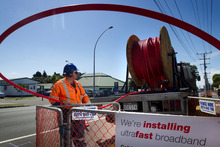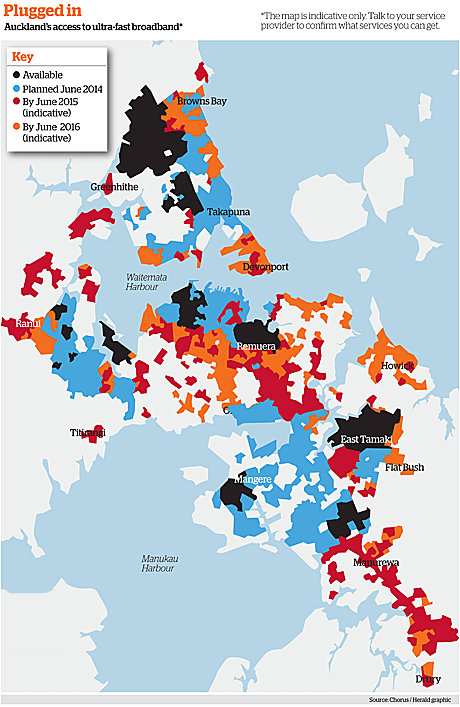Monday Mar 11, 2013

The Government’s $1.5 billion ultra-fast broadband revolution has so far been idling along at dial-up speed.
But the minister overseeing it is optimistic, likening the slow uptake to the teething days of cellphones.
The latest figures put the uptake at 2.6 per cent so far, as the sprawling programme first churns through its list of priority users.
Telecom is getting set to unveil its ultra-fast broadband packages this month, before the nationwide residential build kicks fully into gear.
But the Telecommunications Users Association of New Zealand (Tuanz) says telcos, along with other providers and the Government, could be doing more to make ordinary Kiwis understand what ultra-fast broadband could mean for them.
By the end of 2019, the Government expects 1.35 million Kiwi homes, businesses, schools and health centres will be able to connect to the scheme’s optical fibre technology.
But, from the start of this year, 3806 users of 134,912 able to connect under the UFB scheme had fibre.
Major telcos Telecom and Vodafone are still preparing their UFB plans, but homes and businesses with access to fibre can connect with a range of smaller providers. Service providers in Auckland include CallPlus, Fastcom, InspireNet, Slingshot, Snap, Orcon, Unleash and Xnet.
Tuanz said the uptake rate was higher among “priority users” – schools, hospitals and businesses – with 8 per cent of this group able to connect having done so.
Fibre has been laid past the gates of nearly 700 schools, while the number of schools with fibre connections ready for service stood at 626.
When the number of schools under the separate rural broadband initiative and remote schools broadband initiative is included, 1275 schools were ready for service – about half of the programme target by the end of 2015.
The strongest take-up had been in Whangarei, where Northpower’s full-scale build kicked off ahead of providers elsewhere in the country in April 2011. About 6.4 per cent of 10,461 users with access to the UFB fibre are hooked up. In Christchurch, Enable Networks launched its build in late 2011, and the take-up rate so far is about 5.8 per cent.
Major partner Chorus – which holds the contract for most centres including Auckland, Wellington, Dunedin, Napier, Hastings and Palmerston North – has seen a 1.7 per cent uptake of 80,299 end users able to connect.
The uptake rate was the same under Wel Networks/Ultrafast Fibre’s roll-out across Waikato, Taranaki, Tauranga and Wanganui.
Communications and Information Technology Minister Amy Adams was unsurprised at the rates, telling the Herald they were in line with expectations and overseas experiences. “It takes time for products to be developed for the market and for people to recognise the value of UFB.
“It’s like cellphones – to begin with, a few people had them and then gradually more and more. Now most people can’t think of their lives without a cellphone.”
Ms Adams expected the UFB uptake to have a similar trajectory, increasing markedly as the build reached closer to completion.
She described the initiative as one of the largest and most transformative infrastructure projects to be undertaken in New Zealand.
Fibre deployment was already under way in 24 of the 33 towns and cities across New Zealand that will receive UFB.
“The Government’s focus for encouraging uptake is around schools, health centres, businesses and government agencies as these are the areas likely to see the most widespread benefits from fibre.
“That is why these sectors are the focus of the Government’s five point broadband plan and are a priority for deployment.”
In the last three months of last year, fibre was rolled out to more than 33,000 end users across the country.
Over the same period, under the Rural Broadband Initiative, Vodafone installed 13 new cell towers and upgraded 51 others, and Chorus upgraded 83 roadside cabinets.
To date, 30 new cell towers have been installed and 131 upgraded, as well as 347 cabinets upgraded.
Chorus’ UFB build project general manager Ed Beattie said nearly 100,000 homes and businesses could now order UFB in its area, putting the company on track to achieve its commitments for the year.
In Auckland, the roll-out had reached suburbs including Albany, East Tamaki, Herne Bay, Grey Lynn, Ponsonby and parts of Remuera and Browns Bay.
“Our next step is moving to production-line mode to ensure we have a repeatable, scalable process in our build programme to ensure that we gain more efficiencies in our operations.”
Whangarei is set to become our first fully connected UFB city.
By the end of June, Northpower Fibre’s roll-out would be 71 per cent complete – bringing fibre to more than 13,500 people, chief executive Darren Mason said.
“We are very pleased with the progress of the build and remain confident of completing
Across the centre of the North Island, about 23 per cent of the total network had been completed, meeting ultra-fast fibre’s schedule.
Thirty-four retailers over its eight regions had signed up with the company, and 18 were now able to take orders and connect homes and businesses to its fibre network.
Ultrafast Fibre chief executive Maxine Elliott said UFF was working with retailers, councils and industry to help drive awareness around the technology.
In Christchurch, more than 20,000 homes and businesses could access fibre broadband, which would become available to thousands more over the next few months.
“What’s exciting about the phase we’re entering is that we have a large potential customer base to talk to about the benefits of making the switch to fibre broadband,” Enable chief executive Steve Fuller said.
“We’ve been talking to the Christchurch community and we know there’s demand out there.”
Eighty per cent of respondents in the company’s most recent survey said they would consider connecting to fibre broadband, and 96 per cent of those who had taken it up said they would recommend it to friends and family.
“A big emphasis for Enable over the next few months will be explaining, and working with our retailers to explain, what fibre can do for families and businesses, and how easy and cheap it is to make the move.”
Tuanz chief executive Paul Brislen said he would like to have seen the overall uptake rate reach higher than 2.6 per cent.
“But you’ve got to remember the residential build doesn’t really kick off until 2016 – the figures look relatively low because they are really not trying to sell to the likes of you and me just yet.”
Mr Brislen called on telcos, retailers and the Government to boost publicity efforts.
“There’s been a distinct lack of push from either the Government or retail providers to tell people what it is you can do with this thing – and that’s a lost opportunity, to put it mildly,” he said.
“I’d like to see a real concerted effort made – especially in the small to medium space – to tell people just what it is this can do for their business.”
It could mean an upload speed 10 to 12 times faster at entry level and at the top-end for residential customers, downloading and uploading speeds of 100MB a second.
Business customers could get even faster services and this would open the door to sending large amounts of data to cloud-based networks.
“With those kinds of speeds, you don’t have to worry about backing stuff up anymore.”
For households, installing fibre would effectively future-proof a home for a century of new technology still to come, Mr Brislen said.
The 10-15MB per second download speed at his Mt Roskill home was suitable for his present use, but in the next decade he expected a “tremendous” upsurge in devices that connect with the internet.
“I’m expecting the next fridge I buy will report back to head office every time something breaks, and the same with my air conditioning.”
The biggest appeal of ultra-fast broadband for home users – high-definition streaming of video content – would also prove in great demand for families viewing video throughout a household.
“Copper wiring is not going to be able to deliver that, so you really are future-proofing your home for the next wave – probably for the next 100 years, I would say,” he said.
“Unless somebody invents teleportation, there’s not going to be much that can defeat this type of capability.”
Vodafone spokesperson Emma Carter acknowledged the success of the Government initiative would partly depend on the promotion of its benefits.
Since March last year, Vodafone has offered a free trial to Aucklanders after starting with employees and their friends and family.
Telecom, which has spent the past year developing and testing its UFB products ahead of its commercial residential launch later this month, was taking a “slowly but surely” approach to UFB, spokeswoman Jo Jalfon said.
At the same time, Telecom would also be offering a product for small businesses and schools, before looking to new medium enterprise, corporate-grade products.
“We expect high uptake amongst New Zealand businesses, and have been working for some time to prepare for this,” Ms Jalfon said.
To promote UFB, Telecom had sent out mailers across areas where fibre had been installed and promoted it through a range of advertising and marketing efforts, including its “Tech in a Sec” clips which began airing at primetime on TV One this month.
But Terry Coles, managing director of EOL – the first major internet service provider in the Bay of Plenty to deliver UFB – said there remained a perception the technology was more expensive than it is.
“It’s because people haven’t looked at the whole package,” he said.
“If they look at what they are paying currently for phone and internet, some people could go into fibre and on to a plan that comes out less than what they’re paying now, with a lot more data and a much faster connection. But that message hasn’t really seeped through to users yet – people have to have a reason to change, and if they had a clearer understanding, a lot more people would get a faster connection.”

